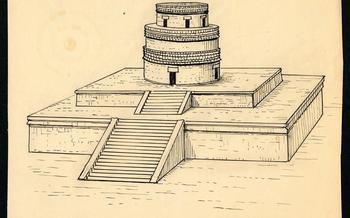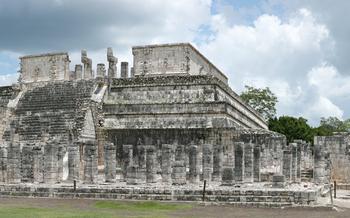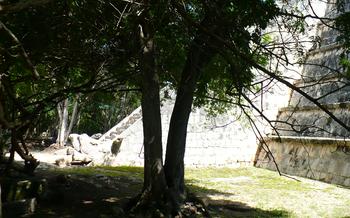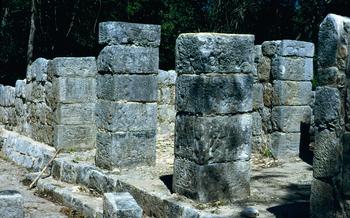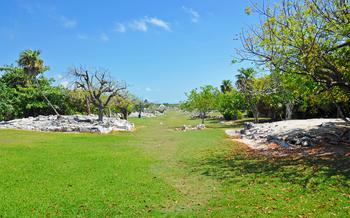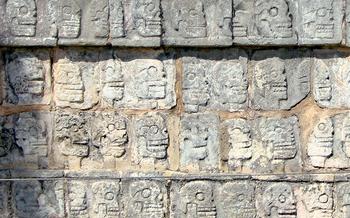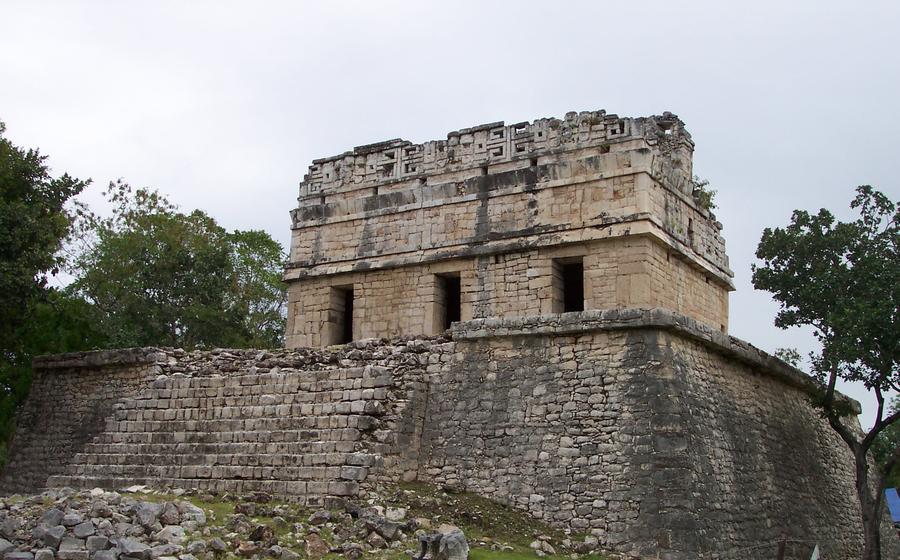
The Red House (Chichanchob)
- A Journey to Chichén Itzá's Hidden Gem: The Red House (Chichanchob)
- Unveiling the Secrets of the Red House
- Stepping into the Past: A Walk Through the Rooms
- Decoding the Stelae and Altars: A Silent Narrative
- Exploring the Surrounding Area: A Wider Perspective
- Tips for Exploring the Red House
- The Red House in Context: The Rise and Fall of Chichén Itzá
- The Legacy of the Red House: Enduring Influence
- The Red House and Modern Conservation Efforts
- The Red House as a Symbol of Cultural Identity
- The Red House and the World Heritage Site
- The Red House in Popular Culture: A Source of Inspiration
- Insider Tip: Discovering Hidden Details
A Journey to Chichén Itzá's Hidden Gem: The Red House (Chichanchob)
Nestled within the sprawling expanse of the Chichén Itzá Archaeological Park lies a captivating treasure trove of Mayan history and culture known as the Red House (Chichanchob). This enigmatic structure stands as a testament to the ingenuity and artistry of the ancient Maya, offering a glimpse into the lives of the elite who once resided within its walls. Located in the heart of the ancient city, the Red House invites visitors to embark on a journey through time, uncovering the secrets of a civilization that continues to captivate the world.
As you approach the Red House, its striking red exterior immediately draws the eye, hinting at the remarkable stories held within. This vibrant hue, derived from the mineral hematite, served as a symbol of power and prestige, reserved for the most important buildings in Mayan society. The Red House stands as a testament to the architectural prowess of the Maya, showcasing their mastery of stone construction and intricate decorative techniques.
Prepare to be awestruck as you step inside the Red House, where a world of wonders unfolds before you. The main room, once the throne room and audience chamber, exudes an aura of grandeur, with its towering walls adorned with exquisite stucco reliefs and vibrant murals depicting scenes from Mayan life. These intricate artworks provide a window into the beliefs, customs, and rituals of this ancient civilization, offering a glimpse into their complex social hierarchy and religious practices.
Venture further into the Red House, and you'll discover a series of inner rooms, each serving a specific purpose. These chambers were once the living quarters of the elite, providing a glimpse into their daily lives. Storage chambers reveal the material wealth and resources at their disposal, showcasing their mastery of agriculture, trade, and craftsmanship. Throughout the Red House, you'll find intricate stucco decorations, vibrant murals, and carefully carved stelae, each telling a unique story about the Maya and their rich cultural heritage.
Unveiling the Secrets of the Red House
The Red House stands as a testament to the grandeur and artistry of the ruling dynasty that once held sway over Chichén Itzá. Its construction showcases the influence of the Puuc architectural style, characterized by intricate stone mosaics and corbelled arches. This unique blend of architectural elements sets the Red House apart from other structures within the archaeological park.
The symbolic significance of the Red House is further revealed through its murals and reliefs, which depict scenes from Mayan life and mythology. These intricate artworks provide a glimpse into the beliefs, rituals, and daily activities of the Mayan elite. The murals showcase a vibrant array of colors, including vibrant reds, blues, and greens, which have remained remarkably well-preserved despite the passage of time.
These artistic representations offer valuable insights into the Mayan worldview and their relationship with the natural world. The murals depict scenes of hunting, agriculture, religious ceremonies, and mythological figures, providing a glimpse into the complex tapestry of Mayan society.
Stepping into the Past: A Walk Through the Rooms
The Red House is not just a remarkable structure from the outside; its interior spaces offer an equally fascinating glimpse into the lives of the ancient Mayans. The main room is believed to have served as a throne room and audience chamber, where the ruling elite received visitors and conducted official business. The walls of this grand space are adorned with intricate stucco reliefs and murals depicting scenes from Mayan life, including hunting, feasting, and religious ceremonies. These artworks provide valuable insights into the social and cultural practices of the Mayan civilization.
Venturing further into the Red House, one encounters a series of smaller, interconnected rooms that likely served as living quarters and storage chambers. These spaces are more intimate in scale and offer a glimpse into the daily lives of the Mayan elites who resided here. The walls of these rooms are adorned with similar stucco reliefs and murals, but they often depict more personal scenes, such as family life, childbirth, and domestic activities. These artworks humanize the ancient Mayans, revealing them not just as powerful rulers but also as ordinary people with families and everyday concerns.
The Red House also features several smaller chambers that may have been used for specific purposes. One such chamber is believed to have been a shrine, as evidenced by the presence of a small altar and offerings. Another chamber may have been used for storage, as it contains a large number of ceramic vessels and other artifacts. These specialized spaces provide further evidence of the complex and multifaceted nature of Mayan life within the Red House.
Decoding the Stelae and Altars: A Silent Narrative
Amidst the ruins of Chichén Itzá, the stelae and altars stand as silent witnesses to the city's rich history and complex belief system. These intricately carved stone monuments offer a glimpse into the lives, rituals, and beliefs of the ancient Maya.
Stelae: Commemorative Monuments with Glyphs and Images
The stelae, tall and imposing, are adorned with a wealth of glyphs and images that narrate the deeds of Mayan rulers, their lineages, and significant events in the city's history. These stone inscriptions provide valuable insights into the political and social structure of Chichén Itzá, as well as the accomplishments of its leaders.
Altars: Sacred Platforms for Offerings and Ceremonies
Complementing the stelae are the altars, low platforms that served as sacred spaces for offerings and ceremonies. These altars were used by the Maya to communicate with their deities, seek guidance, and offer sacrifices to ensure the well-being of their community.
Symbolism: Insights into Mayan Religion and History
The stelae and altars are adorned with a rich array of symbols and iconography that provide clues to Mayan religious beliefs and historical events. These symbols include representations of deities, mythical creatures, and scenes from everyday life, offering a glimpse into the complex worldview of the ancient Maya.
Anecdote: A Puzzle Piece in the Mayan Chronology
During my visit to the Red House, I stumbled upon a stela that caught my attention. It depicted a ruler seated on a throne, surrounded by intricate glyphs. With the help of our guide, I deciphered the text and discovered that the stela commemorated the anniversary of the ruler's coronation. This discovery provided a tangible connection to the past, allowing me to piece together the history of Chichén Itzá and its powerful rulers.
Exploring the Surrounding Area: A Wider Perspective
Venturing beyond the Red House, visitors can delve deeper into the history and significance of Chichén Itzá. Just a short walk away lies the Great Ball Court, an impressive testament to the Mesoamerican ballgame, a ritual sport that held both religious and political importance. The sheer size of the court and the intricate carvings on the surrounding walls offer a glimpse into the grandeur and spectacle of this ancient game.
Nearby, the iconic Temple of Kukulcán, also known as El Castillo, stands tall, its imposing presence a symbol of the power and artistry of the Maya. Dedicated to the feathered serpent god Kukulcán, the temple's striking architecture, with its symmetrical terraces and intricate carvings, draws visitors from around the world. During the spring and autumn equinoxes, the setting sun casts a shadow on the temple's northern staircase, creating the illusion of a serpent slithering down the pyramid, a mesmerizing sight that has become a hallmark of Chichén Itzá.
Another must-visit site is the Sacred Cenote, a natural well that once served as a sacred water source for the Maya. Located just a short distance from the Red House, the cenote was used for rituals, offerings, and rainmaking ceremonies. Visitors can peer into the depths of the cenote and marvel at its crystal-clear waters, imagining the spiritual significance it held for the ancient Maya.
Exploring the surrounding area of the Red House is like embarking on a journey through time and culture, where every step reveals another layer of the rich history and legacy of Chichén Itzá.
Tips for Exploring the Red House
Enrich Your Experience with a Guided Tour
To delve deeper into the history and significance of the Red House, consider joining a guided tour. Knowledgeable guides can provide insights into the architectural features, symbolism, and daily life of the ancient Mayans who inhabited this remarkable structure. They can also offer a broader context of the Red House within the larger archaeological site of Chichén Itzá.
Plan Your Visit for a Peaceful Experience
To fully appreciate the Red House's tranquility and beauty, plan your visit during off-peak hours or quieter times of the day. The early morning or late afternoon hours often offer a more serene atmosphere, allowing you to explore the site without the crowds.
Capture the Essence of the Red House Through Photography
The intricate murals and reliefs that adorn the walls of the Red House present a unique opportunity for photography enthusiasts. Capture the exquisite details and vibrant colors of these ancient artworks, ensuring you have lasting memories of your visit.
Anecdote: A Unique Perspective on Mayan History
During my exploration of the Red House, I stumbled upon a hidden corner adorned with a series of intricate carvings. As I examined them closely, I realized they depicted a hunting scene, showcasing the prowess and skill of the ancient Mayans. This unexpected discovery provided a glimpse into their daily lives and their connection to the natural world.
The Red House in Context: The Rise and Fall of Chichén Itzá
The Red House stands as a testament to the rise and fall of one of the most powerful Maya cities, Chichén Itzá. The city's origins trace back to the 6th century, gradually growing into a prominent center of trade and politics. Chichén Itzá reached its zenith in the 10th and 11th centuries under the rule of the Toltec dynasty, who migrated from central Mexico and brought with them new cultural influences and architectural styles.
During this period, Chichén Itzá became a flourishing metropolis, attracting merchants, artisans, and pilgrims from across the Maya realm. The city's strategic location at the crossroads of major trade routes contributed to its economic prosperity, facilitating the exchange of goods and ideas. Alliances with other Maya city-states further strengthened Chichén Itzá's political power and influence, allowing it to expand its reach and establish a vast trading network.
However, the city's grandeur was not to last. Internal conflicts, environmental challenges, and the rise of rival Maya cities eventually led to Chichén Itzá's decline. The city was gradually abandoned, and its buildings were left to succumb to the forces of time and nature. The once-bustling metropolis became a silent testament to the ephemeral nature of power and the cyclical nature of history.
Anecdote: A Tale of Grandeur and Transformation
Amidst the ruins of Chichén Itzá, the Red House stands as a poignant reminder of the city's former glory. Its intricate carvings and vibrant murals depict scenes of everyday life, religious rituals, and the grandeur of the ruling dynasty. As visitors explore the Red House, they can almost hear the echoes of the past, imagining the bustling markets, the solemn ceremonies, and the vibrant community that once thrived within these walls. The Red House serves as a powerful symbol of the rise and fall of Chichén Itzá, a city that experienced both the heights of power and the depths of decline, leaving behind a legacy that continues to inspire and intrigue generations to come.
The Legacy of the Red House: Enduring Influence
The Red House has left an indelible mark on the architectural, cultural, and contemporary landscape of Mexico. Its unique architectural style, intricate iconography, and historical significance have made it a symbol of Mayan identity and heritage.
Beyond its physical presence, the Red House has influenced the architectural development of other Mayan cities. Elements such as the Puuc-style architecture, the use of stone vaults, and the elaborate stucco decorations have been adopted and adapted in various Mayan settlements.
The Red House also holds cultural significance as a symbol of Mayan identity and heritage. It represents the ingenuity, artistry, and cultural achievements of the Mayan civilization. Its preservation and restoration have become a source of national pride and inspiration for contemporary Mexicans.
In contemporary times, the Red House has served as an inspiration for modern art and design. Its distinctive architectural features, vibrant colors, and intricate motifs have been incorporated into various forms of art, including paintings, sculptures, and textiles. The Red House has become a symbol of cultural continuity, bridging the gap between the ancient Mayan civilization and the modern world.
The Red House and Modern Conservation Efforts
The Red House, a testament to the ingenuity and artistry of the ancient Maya, has captured the attention of archaeologists, conservators, and conservationists worldwide. Ongoing archaeological research aims to uncover more secrets buried beneath the soil, revealing new insights into the lives and culture of the Maya who once inhabited this vibrant city. Preservation initiatives are actively undertaken to protect the site from the ravages of time, ensuring that future generations can continue to appreciate and learn from this remarkable treasure.
Sustainable tourism practices are implemented to balance the need for public access with the preservation of the site's integrity. This delicate balance ensures that the Red House remains a source of inspiration and knowledge for generations to come. Collaborative efforts between archaeologists, conservators, and local communities are essential to preserving the legacy of the Red House while promoting responsible tourism that respects and celebrates Mayan heritage.
The Red House as a Symbol of Cultural Identity
The Red House stands as a powerful symbol of cultural identity for the Maya people. As part of the broader Mayan Revival Movement, the site's rediscovery and subsequent preservation have contributed to a renewed sense of connection with indigenous roots. The Red House has become a source of inspiration and unity, reminding the Maya of their rich cultural legacy. Its enduring significance has led to its adoption as a national symbol, fostering a sense of pride and identity among Mexicans.
Cultural tourism plays a crucial role in promoting understanding and appreciation of the Maya culture. Through initiatives such as guided tours and educational programs, visitors from around the world can gain a deeper understanding of Mayan history and traditions. In this way, the Red House serves as a bridge between the past and the present, connecting people with the enduring legacy of the Maya civilization.
Anecdote: A Bridge Between the Past and the Present
During my visit to the Red House, I had the opportunity to witness firsthand the profound impact it has on visitors. As I observed a group of Maya schoolchildren exploring the site, I noticed their eyes light up with pride and curiosity. Their teacher explained the significance of the Red House and its connection to their ancestors. The children listened intently, eagerly absorbing the knowledge that linked them to their cultural heritage. It was a beautiful moment that demonstrated the power of the Red House to bridge the gap between the past and the present, inspiring a new generation to embrace their Maya identity.
The Red House and the World Heritage Site
The Red House stands as a testament to the cultural significance of the ancient Maya civilization. In recognition of its exceptional value, UNESCO has designated Chichén Itzá, including the Red House, as a World Heritage Site. This prestigious designation highlights the site's outstanding universal value and its contribution to the world's cultural heritage.
UNESCO's recognition reflects the international community's commitment to preserving and protecting this iconic site. Through collaboration and cooperation, experts from around the world work together to ensure the Red House and its surrounding archaeological treasures remain intact for future generations.
As a World Heritage Site, the Red House has become a symbol of global cultural achievement. It represents the rich diversity of human history and the enduring legacy of ancient civilizations. Visitors from around the world come to marvel at the site's intricate architecture, vibrant murals, and profound cultural significance.
Anecdote: Awe-Inspiring Recognition
During my visit to the Red House, I couldn't help but feel a sense of awe at the realization that I was standing in a place of such profound historical and cultural significance. The UNESCO designation serves as a reminder that the Red House is not just a relic of the past but a living testament to the enduring power of human creativity and ingenuity.
The Red House in Popular Culture: A Source of Inspiration
The Red House has captured the imagination of artists, writers, and filmmakers, becoming a source of inspiration for various creative expressions. In literature, the Red House has been featured in books such as "The Maya" by Miguel Ángel Asturias, which weaves a fictionalized account of Mayan civilization around the site. Artists have depicted the Red House's intricate murals and reliefs in paintings and sculptures, capturing its vibrant colors and symbolic motifs.
In the world of film and television, the Red House has served as a backdrop for historical dramas and documentaries. Several documentaries, including the BBC's "Maya: Lords of the Jungle," have showcased the Red House as a testament to Mayan ingenuity and cultural achievements. Filmmakers have also utilized the Red House's unique architecture and atmosphere to create immersive historical dramas set in ancient Maya.
Beyond the realm of documentaries and historical dramas, the Red House's symbolism and imagery have also found their way into popular culture. Mayan motifs and designs inspired by the Red House have been incorporated into contemporary art, fashion, and design, serving as a reminder of the enduring influence of Mayan culture.
Anecdote: A Mayan Icon Beyond Archaeological Boundaries
During my visit to Chichén Itzá, I stumbled upon a unique art exhibition where contemporary artists showcased their interpretations of the Red House. One particular piece, a vibrant painting titled "Echoes of the Maya," depicted the Red House as a living entity, surrounded by swirling colors and ethereal figures. The artist, a Mayan descendant, explained how the Red House had inspired her to explore her cultural heritage through art, bridging the gap between the ancient and the modern.
Insider Tip: Discovering Hidden Details
For the most discerning travelers, uncovering the hidden secrets of the Red House adds a layer of intrigue to their exploration. Look for the inconspicuous entrances to secret passages that lead to concealed chambers and tunnels, offering a glimpse into the hidden world of the ancient Maya. Ascend to the rooftop of the Red House for panoramic views of the surrounding archaeological site, immersing yourself in the grandeur of Chichén Itzá. Finally, take the time to decipher the enigmatic glyphs and motifs adorning the walls, revealing hidden layers of symbolism and meaning. With patience and a keen eye, you'll discover a side of the Red House that few visitors get to experience.
One personal anecdote comes to mind. During my visit, I stumbled upon a hidden passage concealed behind a false wall. With a mix of curiosity and trepidation, I squeezed through the narrow opening and found myself in a small, dimly lit chamber. The walls were adorned with vibrant murals depicting scenes from Mayan mythology. It was as if I had stumbled upon a secret sanctuary, frozen in time. The discovery of this hidden chamber left me with a profound sense of awe and wonder, reminding me that there is always more to uncover in the ancient city of Chichén Itzá.


